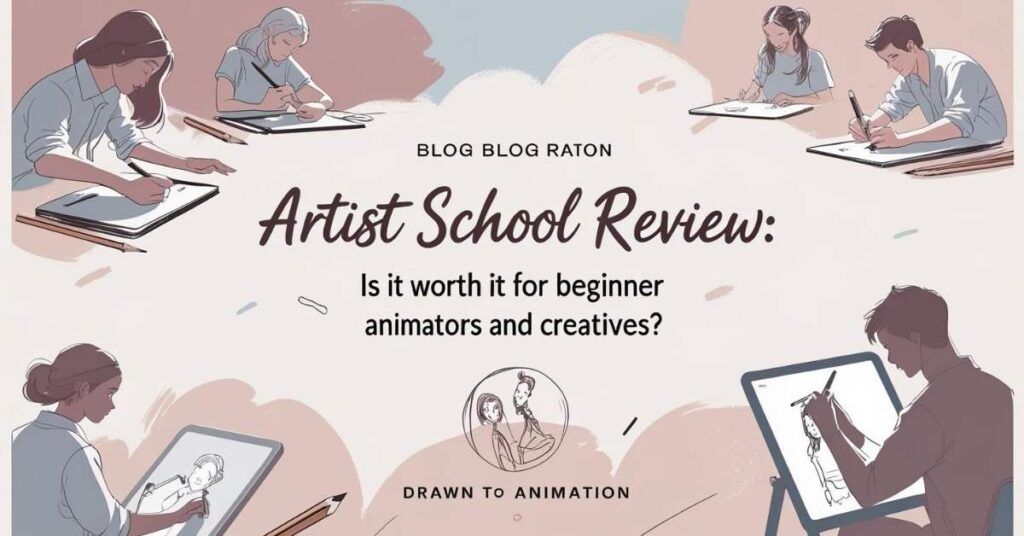I was talking with my friend Sue about learning animation the other day. Everyone has something they dream about learning, and Sue mentioned that she wanted to try teaching herself. I understood the appeal of that. Learning on your own can feel creative and free, but I asked her whether it always works or if having more structure might make things easier. I told her that Artist School is designed to help beginners build their animation skills more quickly and with greater confidence by providing clear lessons, guided feedback, and a structured path to follow. I explained what the platform includes, how it feels to use as a beginner, what it does well, what could be improved, and who it might be best suited for. By the end of our talk, I hoped she would see that both paths have value, but that structured learning can sometimes give beginners a stronger foundation.
What Artist School Actually Offers
When Sue asked what Artist School actually is, I explained that it is more than a collection of random tutorials. Artist School is a structured online platform that teaches animation through step-by-step courses created by experienced artists and instructors. Each course is divided into short, focused lessons that move from simple drawing techniques to more advanced animation projects. The videos are recorded so students can learn at their own pace, and every lesson includes exercises to practice what was shown. Assignments can be uploaded for feedback, allowing beginners to see where they are improving and what still needs work.

I described how the platform is organized in a way that keeps learners from feeling lost. The interface is clean, and each course clearly lists what will be covered, so progress feels easy to follow. There is also a community area where students can post their work and connect with others who are learning the same material. For someone like Sue, who wanted to know where to begin, Artist School was made to provide that direction while still letting her learn at her own speed.
The Learning Experience: Structured, Visual, and Beginner-Friendly
Sue’s next concern was that online courses can feel cold or too technical, the kind of thing that kills creativity instead of sparking it. I explained that the learning experience at Artist School is designed differently. Each lesson is built to feel visual, clear, and encouraging, so beginners stay engaged while learning complex ideas in simple steps. The instructors talk through real examples and demonstrate every concept on screen, showing what good animation looks like instead of just describing it. Each course combines drawing, timing, and movement exercises that build naturally on one another. Even small wins feel rewarding because students can see their progress unfold on screen.

What stood out most to me was how visual everything is. You are never just told what to do—you see it happen and then try it yourself. For someone who learns best by watching, that kind of clarity makes a real difference. The pacing feels steady but never rushed, which helps beginners avoid feeling overwhelmed while still moving forward.
Where Artist School Shines
Sue frowned and said that any school can make its lessons look good, but that does not mean it is worth the money. I agreed with her, but I also pointed out what sets Artist School apart. Its greatest strength is how it gives beginners a professional structure at a beginner’s pace, combining guidance, clarity, and motivation in a single place. Many of the courses are taught by working artists who understand what it is like to start with no experience. Their feedback helps new students avoid common mistakes before those habits become hard to break. The projects are short but focused, teaching one principle at a time—whether it is timing, motion arcs, or expression. There is also the simple confidence that comes from finishing a guided project and seeing your work improve with each attempt.
What Could Be Improved
Sue nodded but said that every course has flaws. She asked me what I thought was missing or weak about Artist School. I admitted there are a few things to keep in mind. While Artist School is well-structured, it is not designed for people who want to master animation theory or advanced production workflows. It is more about building a foundation than creating professional-level reels. Some lessons can feel repetitive for faster learners, and the community, while friendly, is smaller than in some larger platforms. Feedback depends on participation, so if you skip that part, you lose one of the program’s biggest advantages.
These are not deal-breakers, but they are worth knowing before joining. Artist School focuses on early skill-building. Once you have that base, you can move on to more advanced courses elsewhere or even start learning independently with more confidence. That way, you are not wasting time early on trying to guess what to study next.
Who Artist School Is Best For
Sue’s final question was simple. She asked who this type of course is really meant for. I told her that Artist School is best suited for beginners who want structure, feedback, and steady progress, rather than for experienced animators who already understand the fundamentals. It works especially well for visual learners who need to see steps demonstrated clearly. For someone like Sue, who wants to move from curiosity to consistent practice, this kind of guidance can help keep motivation high. But for someone who already knows how to animate short scenes, a more advanced or specialized program might be a better fit.

Learning alone can still work, but it often takes longer because it is easy to get stuck or lose focus. A course like Artist School shortens that path by removing guesswork and giving a clear order to follow. In the end, both choices are valid. It just depends on how you learn best.
If you are ready to take your learning further, here are two trusted options that can guide your next step.
Final Thoughts
As our conversation wound down, I realized that Sue’s questions echoed what many beginners quietly wonder. Artist School offers a guided start for those who want structure and confidence without losing their creative freedom. We had talked about what the platform includes, how the learning process feels, where it excels, what could be improved, and who it is truly meant for. In the end, Sue did not say whether she would sign up, but she left with a clearer sense of what structured learning can offer and why it might be the right choice for anyone who wants to stop guessing and start creating.




























